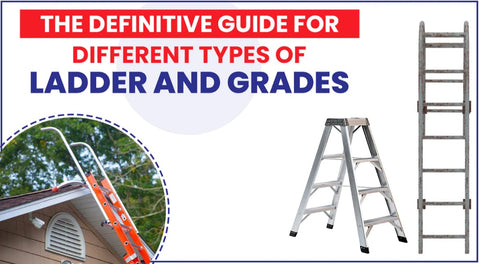
Ladders are very important tools found in workplaces and homes alike. They serve a multitude of purposes, from changing light bulbs to accessing high shelves. However, despite their common usage, ladder accidents remain a significant concern. Understanding the primary causes of these accidents is crucial for promoting safety and preventing injuries.
In this article, we'll look into ladder injury statistics, explore the reasons behind ladder accidents, and provide essential tips for staying safe when using ladders.
Ladder Injury Statistics
Ladder accidents contribute to a considerable portion of workplace injuries and fatalities globally. According to the Occupational Safety and Health Administration (OSHA), falls from ladders are among the leading causes of occupational fatalities and injuries. In the United States alone, thousands of individuals suffer ladder-related injuries each year, with a significant number resulting in severe consequences such as fractures, head injuries, and even death.
Reasons Behind Ladder Accidents :

Several factors contribute to ladder accidents, ranging from human error to equipment malfunction. Understanding these reasons can help individuals and organizations implement preventive measures effectively. Here are some common causes:
-
Selecting the Wrong Type of Ladder:
Using the wrong type of ladder for a particular task significantly increases the risk of accidents. For instance, using a stepladder when an extension ladder is required can lead to instability and falls.
-
Using Damaged or Broken Ladders:
Ladders that are damaged, worn out, or structurally compromised pose a significant hazard. Rungs or steps may be loose, bent, or missing, increasing the likelihood of slips and falls.
-
Incorrect Use of Ladders:
Improper use of ladders, such as overreaching or standing on the top rung, can result in loss of balance and falls. Failure to follow manufacturer's instructions and safety guidelines also contributes to accidents.
-
Incorrect Placement of Ladders:
Placing ladders on uneven or unstable surfaces, such as slippery floors or soft ground, can lead to instability and tipping over. Additionally, improper angle placement against supporting structures increases the risk of the ladder sliding or falling.
Tips to Stay Safe When Using a Ladder (Ladder Safety Tips):

To minimize the risk of ladder accidents and injuries, it's essential to follow proper safety practices. Here are some tips to keep in mind:
-
Always Watch Your Steps:
Pay close attention to where you're stepping, ensuring that your footing is secure on each rung or step. Avoid distractions and maintain focus on the task at hand.
-
Ladder Foot Placement:
Ensure that the ladder's feet are placed on a stable, level surface to prevent tipping or sliding. Use appropriate leveling devices or stabilizers if necessary.
-
Placement of Ladders Against Objects:
When leaning a ladder against a wall or other structure, follow the "4-to-1" rule, which means for every four feet of height, the base of the ladder should be one foot away from the wall. This angle provides optimal stability.
-
Maintain Three Points of Contact:
Always maintain three points of contact with the ladder – two hands and one foot, or two feet and one hand – to ensure stability while climbing or descending.
Ladder accidents are preventable, and by understanding their common causes and following essential safety guidelines, individuals can significantly reduce the risk of injuries. Whether at work or home, prioritizing ladder safety is essential to protect oneself and others from harm. By selecting the right type of ladder, inspecting it for damage, using it correctly, and following safety protocols, accidents can be minimized, and safer environments can be maintained.
FAQ:
- What is the most common cause of ladder accidents?
The most common causes of ladder accidents include selecting the wrong type of ladder, using damaged or broken ladders, incorrect use of ladders, and improper placement of ladders.
- What are the main types of ladder accidents?
Main types of ladder accidents include falls from ladders due to instability, overreaching, and improper use.
- What are the common injuries from falling off a ladder?
Common injuries from falling off a ladder include fractures, head injuries, sprains, and strains.
- At what age should you stop getting on a ladder?
There's no specific age limit for using ladders, but individuals should assess their physical capabilities and consult with healthcare professionals if they have concerns about ladder safety.
Read More Blogs Here:
The Definitive Guide For Different Types of Ladder and Grades





